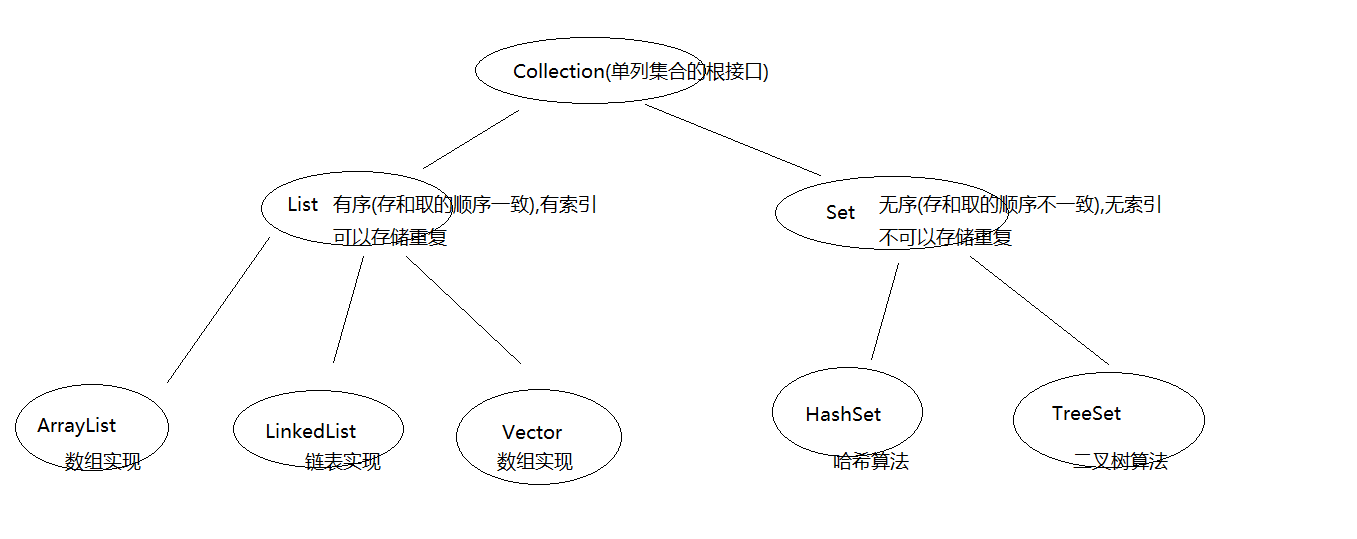Collection
集合,集合是java中提供的一种容器,可以用来存储多个数据。
在前面的学习中,我们知道数据多了,可以使用数组存放或者使用ArrayList集合进行存放数据。那么,集合和数组既然都是容器,它们有啥区别呢?
- 数组的长度是固定的。集合的长度是可变的。
- 集合中存储的元素必须是引用类型数据
集合的继承关系图
a:ArrayList的继承关系:
查看ArrayList类发现它继承了抽象类AbstractList同时实现接口List,而List接口又继承了Collection接口。Collection接口为最顶层集合接口了。
源代码:
interface List extends Collection {
}
public class ArrayList extends AbstractList implements List{
}
b:集合继承体系
这说明我们在使用ArrayList类时,该类已经把所有抽象方法进行了重写。那么,实现Collection接口的所有子类都会进行方法重写。
- Collecton接口常用的子接口有:List接口、Set接口
- List接口常用的子类有:ArrayList类、LinkedList类
- Set接口常用的子类有:HashSet类、LinkedHashSet类
可以看下图了解继承关系

集合Collection的方法
Collection接口中的方法是集合中所有实现类必须拥有的方法,程序演示:ArrayList implements List,List extends Collection
方法的执行,都是实现的重写
Collection接口方法 Object[] toArray() 集合中的元素,转成一个数组中的元素, 集合转成数组
返回是一个存储对象的数组, 数组存储的数据类型是Object

/* Collection接口方法 * Object[] toArray() 集合中的元素,转成一个数组中的元素, 集合转成数组 * 返回是一个存储对象的数组, 数组存储的数据类型是Object */ private static void function_2() { Collection<String> coll = new ArrayList<String>(); coll.add("abc"); coll.add("dashao"); coll.add("xixi"); coll.add("money"); coll.add("123"); Object[] objs = coll.toArray(); for(int i = 0 ; i < objs.length ; i++){ System.out.println(objs[i]); } }
顺便提一下,java中三种长度表现形式
数组.length属性 返回值 int
字符串.length() 方法 返回值 int
集合.size()方法 返回值int
Collection接口方法 boolean contains(Object o) 判断对象是否存在于集合中,对象存在返回true,方法参数是Object类型

private static void function_1() { Collection<String> coll = new ArrayList<String>(); coll.add("abc"); coll.add("dashao"); coll.add("xixi"); coll.add("money"); coll.add("123"); boolean b = coll.contains("itcast"); System.out.println(b); }
Collection接口的方法
* void clear() 清空集合中的所有元素
* 集合容器本身依然存在

public static void function(){ //接口多态的方式调用 Collection<String> coll = new ArrayList<String>(); coll.add("abc"); coll.add("bcd"); System.out.println(coll); coll.clear(); System.out.println(coll); } }
Collection接口方法
* boolean remove(Object o)移除集合中指定的元素

private static void function_3(){ Collection<String> coll = new ArrayList<String>(); coll.add("abc"); coll.add("money"); coll.add("dashao"); coll.add("xixi"); coll.add("money"); coll.add("123"); System.out.println(coll); boolean b = coll.remove("money"); System.out.println(b); System.out.println(coll); }
还有其他方法可以通过查询API了解
迭代器的概述
a:java中提供了很多个集合,它们在存储元素时,采用的存储方式不同。
我们要取出这些集合中的元素,可通过一种通用的获取方式来完成。
b:Collection集合元素的通用获取方式:在取元素之前先要判断集合中有没有元素,
如果有,就把这个元素取出来,继续在判断,如果还有就再取出出来。一直把集合中的所有元素全部取出。这种取出方式专业术语称为迭代。
c:每种集合的底层的数据结构不同,例如ArrayList是数组,LinkedList底层是链表,但是无论使用那种集合,我们都会有判断是否有元素
以及取出里面的元素的动作,那么Java为我们提供一个迭代器定义了统一的判断元素和取元素的方法
实现原理
集合中的迭代器:
* 获取集合中元素方式:接口 Iterator : 两个抽象方法
* boolean hasNext() 判断集合中还有没有可以被取出的元素,如果有返回true
* next() 取出集合中的下一个元素
Iterator接口,找实现类.Collection接口定义方法 Iterator iterator() .ArrayList 重写方法 iterator(),返回了Iterator接口的实现类的对象
使用ArrayList集合的对象, Iterator it =array.iterator(),运行结果就是Iterator接口的实现类的对象, it是接口的实现类对象,调用方法 hasNext 和 next 集合元素迭代
代码实现:

public class IteratorDemo { public static void main(String[] args) { Collection<String> coll = new ArrayList<String>(); coll.add("abc1"); coll.add("abc2"); coll.add("abc3"); coll.add("abc4"); //迭代器,对集合ArrayList中的元素进行取出 //调用集合的方法iterator()获取出,Iterator接口的实现类的对象 Iterator<String> it = coll.iterator(); //接口实现类对象,调用方法hasNext()判断集合中是否有元素 //boolean b = it.hasNext(); //System.out.println(b); //接口的实现类对象,调用方法next()取出集合中的元素 //String s = it.next(); //System.out.println(s); //迭代是反复内容,使用循环实现,循环的条件,集合中没元素, hasNext()返回了false while(it.hasNext()){ String s = it.next(); System.out.println(s); } } }
执行过程
a:迭代器的原理: while(it.hasNext()) { System.out.println(it.next()); } //cursor记录的索引值不等于集合的长度返回true,否则返回false public boolean hasNext() { return cursor != size; //cursor初值为0 } //next()方法作用: //①返回cursor指向的当前元素 //②cursor++ public Object next() { int i = cursor; cursor = i + 1; return elementData[lastRet = i]; } b:for循环迭代写法: for (Iterator<String> it2 = coll.iterator(); it2.hasNext(); ) { System.out.println(it2.next()); }
集合中迭代的转型
A:集合迭代中的转型
- 在使用集合时,我们需要注意以下几点:
集合中存储其实都是对象的地址。
集合中可以存储基本数值吗?jdk1.5版本以后可以存储了。
因为出现了基本类型包装类,它提供了自动装箱操作(基本类型 对象),这样,集合中的元素就是基本数值的包装类对象。
2.存储时提升了Object。取出时要使用元素的特有内容,必须向下转型。
Collection coll = new ArrayList();
coll.add("abc");
coll.add("aabbcc");
coll.add("shitcast");
Iterator it = coll.iterator();
while (it.hasNext()) {
//由于元素被存放进集合后全部被提升为Object类型
//当需要使用子类对象特有方法时,需要向下转型
String str = (String) it.next();
System.out.println(str.length());
}
注意:如果集合中存放的是多个对象,这时进行向下转型会发生类型转换异常。
3.Iterator接口也可以使用<>来控制迭代元素的类型的。代码演示如下:
Collection<String> coll = new ArrayList<String>();
coll.add("abc");
coll.add("aabbcc");
coll.add("shitcast");
Iterator<String> it = coll.iterator();
while (it.hasNext()) {
String str = it.next();
//当使用Iterator<String>控制元素类型后,就不需要强转了。获取到的元素直接就是String类型
System.out.println(str.length());
}
练习:
1.增强for循环遍历数组

/* * JDK1.5新特性,增强for循环 * JDK1.5版本后,出现新的接口 java.lang.Iterable * Collection开是继承Iterable * Iterable作用,实现增强for循环 * * 格式: * for( 数据类型 变量名 : 数组或者集合 ){ * sop(变量); * } */ public static void function_1(){ //for对于对象数组遍历的时候,能否调用对象的方法呢 String[] str = {"abc","dashao","cn"}; for(String s : str){ System.out.println(s.length()); } } /* * 实现for循环,遍历数组 * 好处: 代码少了,方便对容器遍历 * 弊端: 没有索引,不能操作容器里面的元素 */ public static void function(){ int[] arr = {3,1,9,0}; for(int i : arr){ System.out.println(i+1); } System.out.println(arr[0]); }
2.增强for循环遍历集合

/* * 增强for循环遍历集合 * 存储自定义Person类型 */ public static void function_2(){ ArrayList<Person> array = new ArrayList<Person>(); array.add(new Person("a",20)); array.add(new Person("b",10)); for(Person p : array){ System.out.println(p);// System.out.println(p.toString()); } }
泛型的引入
在前面学习集合时,我们都知道集合中是可以存放任意对象的,
只要把对象存储集合后,那么这时他们都会被提升成Object类型。
当我们在取出每一个对象,并且进行相应的操作,这时必须采用类型转换。比如下面程序:
public class GenericDemo { public static void main(String[] args) { List list = new ArrayList(); list.add("abc"); list.add("dashao"); list.add(5);//由于集合没有做任何限定,任何类型都可以给其中存放 //相当于:Object obj=new Integer(5); Iterator it = list.iterator(); while(it.hasNext()){ //需要打印每个字符串的长度,就要把迭代出来的对象转成String类型 String str = (String) it.next();//String str=(String)obj; //编译时期仅检查语法错误,String是Object的儿子可以向下转型 //运行时期String str=(String)(new Integer(5)) //String与Integer没有父子关系所以转换失败 //程序在运行时发生了问题java.lang.ClassCastException System.out.println(str.length()); } } }
泛型的定义和使用
针对上述的类型转换问题,Java 泛型(generics)是 JDK 5 中引入的一个新特性, 泛型提供了编译时类型安全检测机制,该机制允许程序员在编译时检测到非法的类型。泛型的本质是参数化类型,也就是说所操作的数据类型被指定为一个参数。
* 泛型: 指明了集合中存储数据的类型 <数据类型>

public class GenericDemo { public static void main(String[] args) { function(); } public static void function(){ Collection<String> coll = new ArrayList<String>(); coll.add("abc"); coll.add("rtyg"); coll.add("43rt5yhju"); // coll.add(1); Iterator<String> it = coll.iterator(); while(it.hasNext()){ String s = it.next(); System.out.println(s.length()); } } }
Java中的伪泛型:
泛型只在编译时存在,编译后就被擦除,在编译之前我们就可以限制集合的类型,起到作用
例如:ArrayList<String> al=new ArrayList<String>();
编译后:ArrayList al=new ArrayList();
泛型类
a:定义格式:
修饰符 class 类名<代表泛型的变量> { }
例如,API中的ArrayList集合:
class ArrayList<E>{ public boolean add(E e){ } public E get(int index){ } }
b:使用格式:
创建对象时,确定泛型的类型
例如,ArrayList<String> list = new ArrayList<String>();
此时,变量E的值就是String类型
class ArrayList<String>{ public boolean add(String e){ } public String get(int index){ } }
例如,ArrayList<Integer> list = new ArrayList<Integer>();
此时,变量E的值就是Integer类型
class ArrayList<Integer>{ public boolean add(Integer e){ } public Integer get(int index){ } }
泛型的方法
a:定义格式:修饰符 <代表泛型的变量> 返回值类型 方法名(参数){ }
b:泛型方法的使用:
1:例如,API中的ArrayList集合中的方法:
public <T> T[] toArray(T[] a){ }
//该方法,用来把集合元素存储到指定数据类型的数组中,返回已存储集合元素的数组
使用格式:调用方法时,确定泛型的类型
例如:
ArrayList<String> list = new ArrayList<String>();
String[] arr = new String[100];
String[] result = list.toArray(arr);
此时,变量T的值就是String类型。变量T,可以与定义集合的泛型不同
public <String> String[] toArray(String[] a){ }
例如:
ArrayList<String> list = new ArrayList<String>();
Integer[] arr = new Integer[100];
Integer [] result = list.toArray(arr);
此时,变量T的值就是Integer类型。变量T,可以与定义集合的泛型不同
public <Integer> Integer[] toArray(Integer[] a){ }
泛型接口

//带有泛型的接口 public interface List <E>{ abstract boolean add(E e); } // 实现类,先实现接口,不理会泛型 public class ArrayList<E> implements List<E>{ } // 调用者 : new ArrayList<String>() 后期创建集合对象的时候,指定数据类型 // 实现类,实现接口的同时,也指定了数据类型 public class XXX implements List<String>{ } new XXX() public class GenericDemo2 { }
好处:
a:将运行时期的ClassCastException,转移到了编译时期变成了编译失败。
b:避免了类型强转的麻烦。

public class GenericDemo { public static void main(String[] args) { List<String> list = new ArrayList<String>(); list.add("abc"); list.add("itcast"); //list.add(5);//当集合明确类型后,存放类型不一致就会编译报错 //集合已经明确具体存放的元素类型,那么在使用迭代器的时候,迭代器也同样会知道具体遍历元素类型 Iterator<String> it = list.iterator(); while(it.hasNext()){ String str = it.next(); System.out.println(str.length()); //当使用Iterator<String> //控制元素类型后,就不需要强转了。获取到的元素直接就是String类型 } } }
泛型的通配符
类型通配符一般是使用?代替具体的类型参数。例如 List<?> 在逻辑上是List<String>,List<Integer> 等所有List<具体类型实参>的父类。

/* * 泛型的通配符 */ public class GenericDemo { public static void main(String[] args) { ArrayList<String> array = new ArrayList<String>(); HashSet<Integer> set = new HashSet<Integer>(); array.add("123"); array.add("456"); set.add(789); set.add(890); iterator(array); iterator(set); } /* * 定义方法,可以同时迭代2个集合 * 参数: 怎么实现 , 不能写ArrayList,也不能写HashSet * 参数: 或者共同实现的接口 * 泛型的通配,匹配所有的数据类型 ? */ public static void iterator(Collection<?> coll){ Iterator<?> it = coll.iterator(); while(it.hasNext()){ //it.next()获取的对象,什么类型 System.out.println(it.next()); } } }
泛型的限定:
通过下面例子了解泛型的限定

/* * 将的酒店员工,厨师,服务员,经理,分别存储到3个集合中 * 定义方法,可以同时遍历3集合,遍历三个集合的同时,可以调用工作方法 */ import java.util.ArrayList; import java.util.Iterator; public class GenericTest { public static void main(String[] args) { //创建3个集合对象 ArrayList<ChuShi> cs = new ArrayList<ChuShi>(); ArrayList<FuWuYuan> fwy = new ArrayList<FuWuYuan>(); ArrayList<JingLi> jl = new ArrayList<JingLi>(); //每个集合存储自己的元素 cs.add(new ChuShi("张三", "后厨001")); cs.add(new ChuShi("李四", "后厨002")); fwy.add(new FuWuYuan("翠花", "服务部001")); fwy.add(new FuWuYuan("酸菜", "服务部002")); jl.add(new JingLi("小名", "董事会001", 123456789.32)); jl.add(new JingLi("小强", "董事会002", 123456789.33)); // ArrayList<String> arrayString = new ArrayList<String>(); iterator(jl); iterator(fwy); iterator(cs); }

/* * 定义方法,可以同时遍历3集合,遍历三个集合的同时,可以调用工作方法 work * ? 通配符,迭代器it.next()方法取出来的是Object类型,怎么调用work方法 * 强制转换: it.next()=Object o ==> Employee * 方法参数: 控制,可以传递Employee对象,也可以传递Employee的子类的对象 * 泛型的限定 本案例,父类固定Employee,但是子类可以无限? * ? extends Employee 限制的是父类, 上限限定, 可以传递Employee,传递他的子类对象 * ? super Employee 限制的是子类, 下限限定, 可以传递Employee,传递他的父类对象 */ public static void iterator(ArrayList<? extends Employee> array){ Iterator<? extends Employee> it = array.iterator(); while(it.hasNext()){ //获取出的next() 数据类型,是什么Employee Employee e = it.next(); e.work(); } } }
